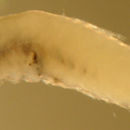en
names in breadcrumbs


Diagnosis: Modal fin-ray counts of D-VI,11 A-12 and Pect-16-17 indicate Ctenogobius boleosoma, C. smaragdus, and Evorthodus lyricus. These genera typically have one more anal-fin ray than second-dorsal-fin rays. C. smaragdus occurs in Florida and Cuba, as well as Venezuela to Brazil and thus is not included in this larval type. (DNA)
Analogues: (post-anal-fin solitary melanophore, large: >9 mm SL) Metamorphic melanophores comprising an oblique bar forward of the eye to the mid-upper jaw and pelvic fins almost reaching the vent confirms C. boleosoma. A bar from the iris to the corner of the mouth indicates C. saepepallens. Evorthodus lyricus has a markedly shorter pelvic fin than C. boleosoma (or C. saepepallens) and a more appropriate larval type is identified for that species. Pre-transitional larvae of this C. boleosoma type are distinct in having a solitary melanophore at the tip of the lower jaw, but those without the spot would be indistinguishable from pre-transitional C. saepepallens (since there is some overlap in fin-ray counts). This conclusion is based on the fact that larvae in which that is the sole head marking usually have 12 anal-fin elements and thus likely represent C. boleosoma (C. saepepallens has a mode of 13 anal-fin elements)
Description: Body thin, long, and narrow with a large eye and a terminal medium-sized mouth. Pectoral fins medium length, reaching about two-thirds of the way to the vent (longer at transition). Pelvic fins long and fused with a clear frenum, reaching much of the way to the vent. Dorsal and anal-fin bases long, caudal peduncle relatively short and narrow. The s-shaped gut is usually clearly visible through the ventral abdominal wall. Lightly marked mostly along the lower body: melanophores along the ventral midline at the isthmus (often missing), at the pelvic-fin insertion, and then sometimes another just behind the pelvic-fin insertion, after which some individuals develop a row on each side of the gut strip along the abdomen. There are several discrete large melanophores along the anal-fin base, often variably present and variably paired (usually only 3-4 per side, but can be up to 7; can occur on either side unpaired), and a prominent and characteristic melanophore (rarely two) at the ventral midline of the caudal peduncle after the last anal-fin ray which has an internal extension reaching up towards the lateral midline. In many individuals, especially earlier-stage larvae, some melanophores are missing or indistinct and even the characteristic deep peduncle melanophore is often not visible. Head markings typically develop as a melanophore between the mid-upper jaw and eye (any melanophores extending from the eye to the corner of the mouth or a solitary melanophore on the iris surface at that quadrant indicate C. saepepallens; transitional C. boleosoma do have melanophores on the lower iris, but always in combination with other transitional melanophores). Most pre-transitional larvae have a solitary melanophore at the tip of the lower jaw, but whether this is a rule is unclear since some variant transitional larvae recognizable as C. boleosoma are missing this melanophore. Internal melanophores are present around the saccule, the dorsal surface of the swim bladder, and around the gut near the vent: Some individuals have a deep melanophore above the pelvic girdle between the thoracic and abdominal cavities. Series of transitional larvae show development of the eye from a slightly narrowed vertical oval to distinctly larger and round, often with a dorsal dent in the iris that sometimes persists into the transitional phase. The head profile develops from a thin pointed head to a blunt snout with a particularly bulbous head compared to the midsection. Transitional larvae develop a pattern of discrete melanophores on the jaw and the head (primarily in a stripe forward of the eye and in pairs on top of the head) and patches of characteristic tiny leukophores (clearly smaller and more numerous than on C. saepepallens) on the upper iris, on top of the head, and in a stripe forward across the nasal region and along the upper jaw. Patches of melanophores then develop along the dorsal midline and on the lateral midline of the caudal peduncle. Transitional recruits develop additional specklings of melanophores, leukophores, and iridophores and a prominent row of lateral midline blotches. A conspicuous black spot develops at the base of the upper pectoral-fin rays.